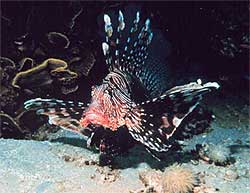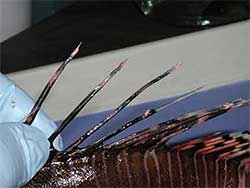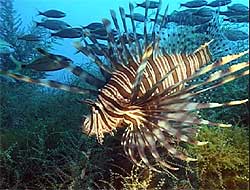Neuroscience For Kids
Lionfish: A Fish to Avoid
 January 1,
2012
January 1,
2012
Lionfish (Pterois volitans) have been invading the coastal waters of the eastern United States and the Caribbean islands for several years. The National Oceanic and Atmospheric Administration (NOAA) believes that the East Coast invasion of lionfish started when people dumped their pet lionfish into the ocean. As a way to stop the spread of lionfish, restaurants in several countries have placed the tasty fish on their menus.
 Catching lionfish is not without danger. These fish
have a venom gland located at the base of each spine. A sting from
a spine can be quite painful because the venom has a combination of
protein, a neuromuscular toxin and the neurotransmitter called acetylcholine. After a spine punctures the skin, the
venom travels up a groove in the lionfish's spine into the wound.
Catching lionfish is not without danger. These fish
have a venom gland located at the base of each spine. A sting from
a spine can be quite painful because the venom has a combination of
protein, a neuromuscular toxin and the neurotransmitter called acetylcholine. After a spine punctures the skin, the
venom travels up a groove in the lionfish's spine into the wound.
The venom is not the only neurotoxic danger posed by the lionfish. Officials on the island of St. Martin are warning people not to eat lionfish because tests have found ciguatoxin in the flesh of the fish. Ciguatoxin works by opening sodium channels on nerve cells and can lead to cardiovascular problems, respiratory depression and even death.
 The most common treatment for a lionfish sting is
to:
The most common treatment for a lionfish sting is
to:
- Remove the spine (if it broke off in the skin).
- Place the wound in hot (45 degrees C) water for 30-90 minutes or until the pain is gone.
- Get a tetanus shot and possibly antibiotics.
LIONFISH: beautiful, but dangerous. Look, but don't touch...and don't eat, at least in St. Martin!
References and further information:
- Ciguatera Toxicity
- NOAA scientists hunt for lions
- Red Lionfish
- Lionfish and stonefish
- Vetrano, S.J., Lebowitz, J.B. and Marcus, S. Lionfish envenomation. Journal of Emergency Medicine, 23:379-382, 2002.
- Church, J.E., Moldrich, R.X., Beart, P.M. and Hodgson, W.C. Modulation of intracellular Ca2+ levels by Scorpaenidae venoms, Toxicon., 41:679-689, 2003.
- Garyfallou, G.T. and Madden, J.F. Lionfish envenomation, Annals of Emergency Medicine, 28:456-457, 1996.
Copyright © 1996-2012, Eric H. Chudler, University of Washington
